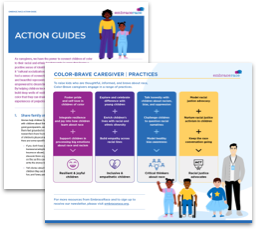3 Ways to Integrate Resilience and Joy into How Kids Learn about Race
It’s easy to reduce the story of race to one of prejudice and discrimination. However, race is also a story about joy, family, community, resilience, allyship, grassroots resistance, and laugh-out-loud humor. Be sure that all of these are in the mix of your discussions and explorations about race with the children in your life.
Books are critical tools for teaching about racism. Books also provide incredible opportunities to show children that the lives of people of color are full of joy, courage, and resistance even when those lives are marked by hardship. Talk with your child/student about what books interest them and consult a librarian and/or Social Justice Books or Diverse Book Finder to find books that match your child’s/student’s interests. If you and your child/student need a starting place, please click here to see EmbraceRace’s list of “20 Picture Books for 2020: Readings to Embrace Race, Provide Solace, and Do Good.”
Some examples of books that highlight resilience, resistance, and joy are:
Resilience
- Hammering for Freedom by Rita Lorraine Hubbard and John Holyfield
- Saturday by Oge Mora
- Side by Side / Lado a Lado: The Story of Dolores Huerta and Cesar Chavez / La Historia de Dolores Huerta y Cesar Chavez by Monica Brown and Joe Cepeda
Resistance
- Hands Up! by Breanna J. McDaniel and Shane W. Evans
- Sometimes People March by Tessa Allen
- We Are Water Protectors by Carole Lindstrom and Michaela Goade
Joy
- Black is a Rainbow Color by Angela Joy and Ekua Holmes
- Going Down Home with Daddy by Kelly Starling Lyons and Daniel Minter
- My Papi has a Motorcycle by Isabel Quintero and Zeke Peña
Research tells us that connections to loving, trusted, supportive adults are key to building well-being and resilience among children. These connections also provide opportunities to highlight the joy, resilience, and resistance embodied by members of children’s social worlds.
Activity Ideas
-
Connect children with their family, community elders, and other loving and supportive role models.
Involve them in family and community gatherings and share stories about joy, love, and resistance from older generations with them.
-
Celebrate family members’ milestones and achievements, from first steps to graduations and wedding anniversaries.
And don’t hesitate to help celebrate milestones and achievements in your friends’ or neighbors’ lives.
-
As Mr. Rogers said, “Look for the helpers.”
Who are the activists and organizers in your community? Learn together with children and get excited about the brave work people are doing.
-
Connect the past to the present and talk about traditions of resistance in communities of color.
For more tips, check out another EmbraceRace Action Guide, “7 Ways to Highlight Resistance Efforts When Discussing Oppression with Children.”
Make the most of small habits and daily activities to create joyful experiences for children and build their ability to thrive despite adversity.
Activity Ideas
-
Join or build a community of like-minded caregivers and/or educators who are also on the journey of raising kids who are thoughtful, informed, and brave about race.
Dr. Suniya Luthar, Co-Founder and Chief Research Officer of Authentic Connections Groups, reminds us that “resilience rests on relationships.” We often associate caregivers with the image of putting on their oxygen masks before helping others. Dr. Luthar highlights the importance of caregivers having someone/a community to help them put on their oxygen mask. Consider joining an EmbraceRace community or affinity group.
-
Practice gratitude.
Research shows a strong correlation between gratitude and happiness. Build habits around naming what you are grateful for (think 2 things each day, or 3-5 things each week), from big things (like being alive and healthy) to small moments (like having your favorite dinner). You can do this together as a family or a classroom, or encourage children to write these down individually in a gratitude journal. If you do decide to try gratitude journaling, consider these tips.
-
Practice self-care.
Protecting our own physical, emotional, and psychological well-being allows us to better care for others. Identify 2-4 specific ways you personally find joy, strength, and peace. What helps you recharge? Reading? Meditating? Exercising? Drawing? Time with friends? Then, help your child think through what does the same for them. Prioritize and make time for those activities.
-
Promote a belief in effort and practice.
Research shows that children who believe that their abilities are changeable (as in, you can get better with effort and support) are more likely to persevere when they encounter difficult problems or challenges. One way to help instill this belief in children is to celebrate their efforts, rather than their innate talents. So instead of “Wow! You are so smart! What a genius!” try incorporating some encouragement like, “Wow! You worked so hard on that! You really put the time into figuring that out! That was some great problem-solving.” If you are raising and/or working with a child of color, the belief in and nurturing of “Black/Brown excellence” is not antithetical to nurturing flexible thinking. The caregiver or educator would simply pair the celebration of Black/Brown excellence with encouragement of effort and the belief that we get better and better through practice.
-
Explicitly identify and discuss moments of resistance, resilience, and joy when reading books and discussing current events related to race.
-
Create joyful moments together as a family.
De-stress by laughing and having fun together. Play games, play music, dance, cook, go for a walk, paint each other’s portraits – all of that counts!
-
For young children, check out these self-affirming Joyful ABC activity booklets created by the National Museum of African American History and Culture, with sets for ages 0-2 and 3-5.
